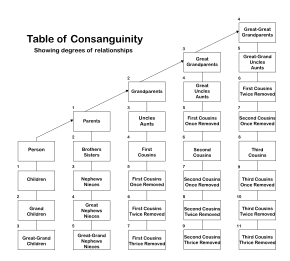
Consanguinity (from Latin consanguinitas 'blood relationship') is the characteristic of having a kinship with a relative who is descended from a common ancestor.
Many jurisdictions have laws prohibiting people who are related by blood from marrying or having sexual relations with each other. The degree of consanguinity that gives rise to this prohibition varies from place to place.[2] On the other hand, around 20% of the global population lives in areas where consanguinous marriages are preferred.[3] The degree of relationships are also used to determine heirs of an estate according to statutes that govern intestate succession, which also vary from jurisdiction to jurisdiction.[4] In some communities and time periods, cousin marriage is allowed or even encouraged; in others, it is taboo, and considered to be incest.
The degree of relative consanguinity can be illustrated with a consanguinity table in which each level of lineal consanguinity (generation or meiosis) appears as a row, and individuals with a collaterally consanguineous relationship share the same row.[5] The Knot System is a numerical notation that describes consanguinity using the Ahnentafel numbers of shared ancestors.[6]
- ^ "19 Texas Administrative Code §100.1113". texreg.sos.state.tx.us. State of Texas. Retrieved 5 May 2022. Many other US states have the same definition.
- ^ O'Sullivan, Kathryn (2019). "Access to marriage: consanguinity and affinity prohibitions in national and international context". Irish Journal of Family Law. 22 (2): 8–12.
- ^ Modell, Bernadette; Darr, Aamra (March 2002). "Science and society: genetic counselling and customary consanguineous marriage". Nature Reviews. Genetics. 3 (3): 225–229. doi:10.1038/nrg754. ISSN 1471-0056. PMID 11972160. Retrieved 2024-08-09.
- ^ Ritchie, Herbert (1940). "Methods of Intestate Succession". University of Cincinnati Law Review. 14: 508.
- ^ "Table of Consanguinity". Sleepy Hollow Cemetery.
- ^ Højrup, Knud (June 1996). "The Knot System: A Numeric Notation of Relationship". National Genealogical Society Quarterly. 84 (2): 115. ISSN 0027-934X.